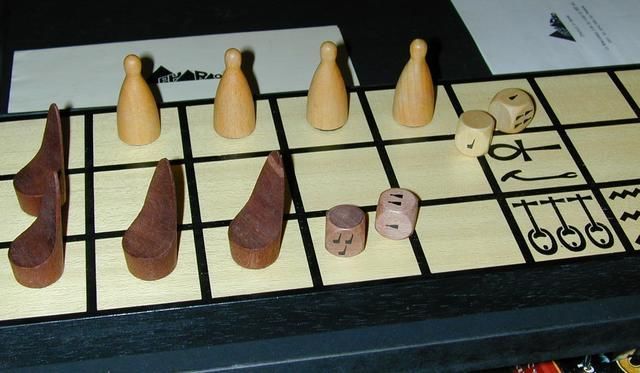Pharao is an abstract strategy board game that was released in in 1984. It is designed for 2 players and has a runtime of around 30 minutes. The game is set in ancient Egypt and incorporates elements of dice rolling and moving pieces on the board. The game is suitable for players aged 7 and above.
Game Components of Pharao
Board: Divided into three rows of ten squares each, called “Houses”.Pieces: Four playing pieces per player, shaped like the crowns of Lower Egypt (dark player) and Upper Egypt (light player).Dice: Two dice per player, one marked with silhouettes of the player’s own pieces and the other with silhouettes of the opponent’s pieces. The dice are marked 0 – 0 – 1 – 2 – 3 – 4 and 0 – 0 – 1 – 1 – 2 – 2.
How To Setup Pharao
To set up Pharao, players decide randomly which player will be dark and which will be light. The light player places their pieces on houses 2 through 5, while the dark player places their pieces on houses 20 through 23. Players should switch sides when playing successive games.
Gameplay Mechanics and Game Objective
Turn Structure: A player throws both dice simultaneously, moving one of their own pieces according to the first die and one of the opponent’s pieces according to the second die.Movement: Pieces move orthogonally (up, down, or sideways) to neighboring empty houses. A piece cannot enter an occupied house or end its move on an occupied house.House of Humiliation: If a piece is moved onto the House of Humiliation, it is removed from play unless the opponent can move it to safety on their turn.House of Beauty: This house allows a player to rescue a drowning piece by moving it three houses away from the House of Humiliation.Objective: The goal is to move all of your pieces around the board while hindering your opponent’s progress. A player loses if they lock themselves up with no legal moves.
Player Experience
Pharao offers a mix of strategy and luck, making each game unique. Players need to think ahead to avoid trapping their own pieces while trying to disrupt their opponent’s movements. The game requires careful planning and a bit of luck from the dice rolls.
Pros
Historical Basis: Faithfully recreates elements of the ancient Senet game, adding a layer of historical intrigue.Simple yet Challenging: Easy to learn but challenging to master, making it appealing to a wide range of players.Interactive: Players are actively engaged in each other’s turns, as they can affect each other’s pieces directly.
Cons
Luck Factor: The game involves a significant amount of luck due to the dice rolls, which may not appeal to players seeking pure strategy.Limited Pieces: Only four pieces per player, which might make the game feel less complex compared to other board games.
Personal Thoughts on Pharao
Pharao is for players interested in historical games and those who enjoy a balance between strategy and luck. It is an excellent choice for two players looking for a game that is both intellectually stimulating and historically rich. While it may not offer the complexity of larger, more modern board games, Pharao provides a unique and engaging experience that is well worth exploring.
We are supported by our audience. When you purchase through links on our site, we may earn an affiliate commission, at no extra cost for you. Learn more.

